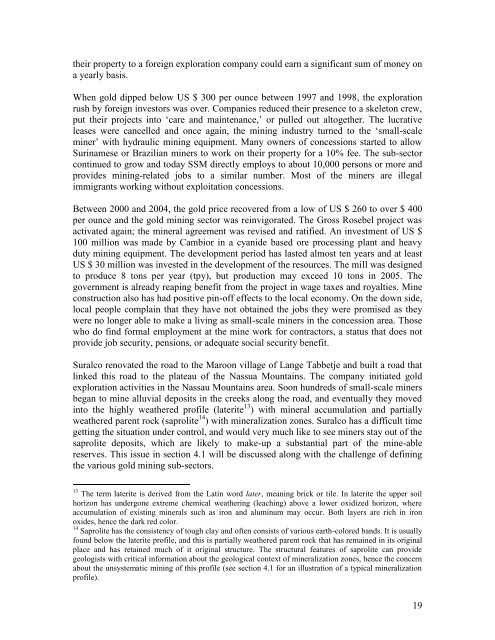SITUATION ANALYSIS OF THE SMALL-SCALE GOLD ... - WWF
SITUATION ANALYSIS OF THE SMALL-SCALE GOLD ... - WWF
SITUATION ANALYSIS OF THE SMALL-SCALE GOLD ... - WWF
You also want an ePaper? Increase the reach of your titles
YUMPU automatically turns print PDFs into web optimized ePapers that Google loves.
their property to a foreign exploration company could earn a significant sum of money on<br />
a yearly basis.<br />
When gold dipped below US $ 300 per ounce between 1997 and 1998, the exploration<br />
rush by foreign investors was over. Companies reduced their presence to a skeleton crew,<br />
put their projects into „care and maintenance,‟ or pulled out altogether. The lucrative<br />
leases were cancelled and once again, the mining industry turned to the „small-scale<br />
miner‟ with hydraulic mining equipment. Many owners of concessions started to allow<br />
Surinamese or Brazilian miners to work on their property for a 10% fee. The sub-sector<br />
continued to grow and today SSM directly employs to about 10,000 persons or more and<br />
provides mining-related jobs to a similar number. Most of the miners are illegal<br />
immigrants working without exploitation concessions.<br />
Between 2000 and 2004, the gold price recovered from a low of US $ 260 to over $ 400<br />
per ounce and the gold mining sector was reinvigorated. The Gross Rosebel project was<br />
activated again; the mineral agreement was revised and ratified. An investment of US $<br />
100 million was made by Cambior in a cyanide based ore processing plant and heavy<br />
duty mining equipment. The development period has lasted almost ten years and at least<br />
US $ 30 million was invested in the development of the resources. The mill was designed<br />
to produce 8 tons per year (tpy), but production may exceed 10 tons in 2005. The<br />
government is already reaping benefit from the project in wage taxes and royalties. Mine<br />
construction also has had positive pin-off effects to the local economy. On the down side,<br />
local people complain that they have not obtained the jobs they were promised as they<br />
were no longer able to make a living as small-scale miners in the concession area. Those<br />
who do find formal employment at the mine work for contractors, a status that does not<br />
provide job security, pensions, or adequate social security benefit.<br />
Suralco renovated the road to the Maroon village of Lange Tabbetje and built a road that<br />
linked this road to the plateau of the Nassua Mountains. The company initiated gold<br />
exploration activities in the Nassau Mountains area. Soon hundreds of small-scale miners<br />
began to mine alluvial deposits in the creeks along the road, and eventually they moved<br />
into the highly weathered profile (laterite 13 ) with mineral accumulation and partially<br />
weathered parent rock (saprolite 14 ) with mineralization zones. Suralco has a difficult time<br />
getting the situation under control, and would very much like to see miners stay out of the<br />
saprolite deposits, which are likely to make-up a substantial part of the mine-able<br />
reserves. This issue in section 4.1 will be discussed along with the challenge of defining<br />
the various gold mining sub-sectors.<br />
13 The term laterite is derived from the Latin word later, meaning brick or tile. In laterite the upper soil<br />
horizon has undergone extreme chemical weathering (leaching) above a lower oxidized horizon, where<br />
accumulation of existing minerals such as iron and aluminum may occur. Both layers are rich in iron<br />
oxides, hence the dark red color.<br />
14 Saprolite has the consistency of tough clay and often consists of various earth-colored bands. It is usually<br />
found below the laterite profile, and this is partially weathered parent rock that has remained in its original<br />
place and has retained much of it original structure. The structural features of saprolite can provide<br />
geologists with critical information about the geological context of mineralization zones, hence the concern<br />
about the unsystematic mining of this profile (see section 4.1 for an illustration of a typical mineralization<br />
profile).<br />
19
















